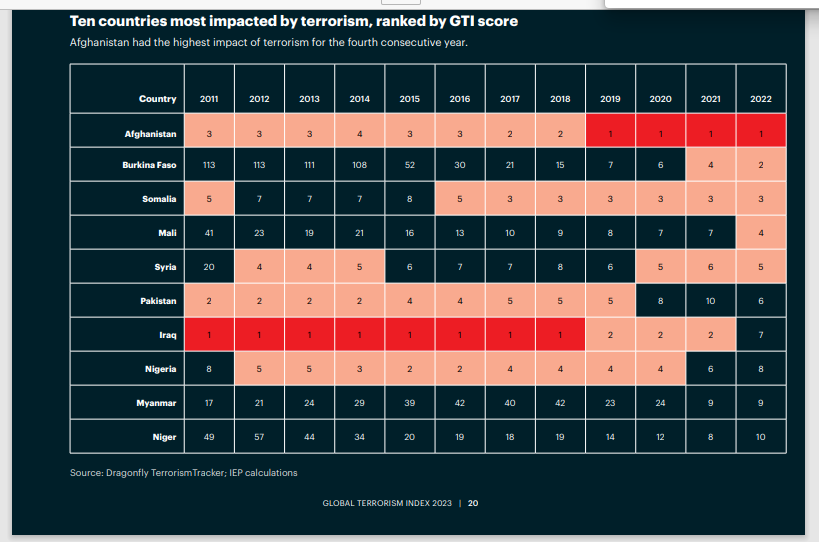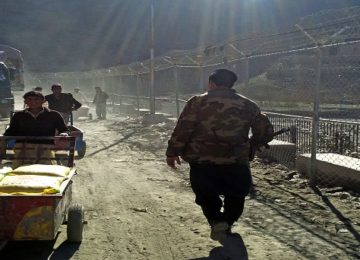Violent conflict remains the primary driver of terrorism, with over 88 per cent of attacks and 98 per cent of terrorism deaths in 2022 taking place in countries in conflict. All ten countries most impacted by terrorism were also involved in an armed conflict. Terrorism was widespread in Afghanistan with terrorist incidents recorded in 26 out of 34 provinces. While in Pakistan, terrorism-related deaths attributed to BLA are now at their highest level in the last two decades, with 233 deaths recorded in 2022. This is a ninefold increase compared to the 26 deaths recorded in 2021.
The tenth edition of Global Terrorism Index (GTI) offers a thorough overview of the most important global trends and patterns in terrorism over the previous ten years. The GTI score is calculated by weighting incidents, hostage situations, and terrorist-related deaths during a five-year period.
Deaths from terrorism decreased by 9% in 2022 to 6,701 deaths, which is 38% less than the peak in 2015. Attacks decreased by almost 28% from 5,463 in 2021 to 3,955 in 2022, mirroring the decline in fatalities, which fell by a similar percentage.
South Asia remains the region with the worst average GTI score in 2022. There were 1,354 terrorist deaths throughout the region, a 30% drop from the year before. Both the newly formed National Resistance Front (NRF) and the IS Khorasan chapter constitute a severe threat to Afghanistan. In 2022, Afghanistan and Pakistan were still among the top ten nations afflicted by terrorism. In Pakistan, the number of fatalities increased considerably from 292 in 2021 to 643, an increase of 120%. The BLA, the world’s fastest-growing terrorist organisation, was responsible for one-third of these fatalities in Pakistan, a ninefold rise from the previous year.
Nonetheless, the number of terrorist deaths would have climbed by 4% if Afghanistan hadn’t been included in the index. Despite a decline in terrorist attacks and fatalities of 75% and 58%, respectively, Afghanistan continued to be the country most affected by terrorism for the fourth consecutive year. Acts done by the Taliban after they took over the government are no longer covered by the GTI since it does not include acts of governmental repression and violence by state actors.
Islamic State (IS) and its affiliates were the deadliest terrorist organisations in the world in 2022, followed by al-Shabaab, the Balochistan Liberation Army (BLA), and Jamaat Nusrat Al-Islam wal Muslimeen (JNIM). For the ninth year in a row, IS remained the deadliest terrorist organisation on the planet. However, there has been a rapid increase in deaths attributed to unknown jihadists in the countries where ISWA operates, increasing by 17 times since 2017 to 1,766 terrorism deaths. Given the location, many of these are likely unclaimed attacks by ISWA. If most of the deaths caused by unknown jihadists were included as IS terrorism deaths, then the outcome would have been similar to 2021. Eighteen countries experienced a death from terrorism caused by IS in 2022, a slight decrease from 20 countries the year prior.
After the substantial falls in terrorism between 2015 and 2019, improvements have plateaued in the last three years. Highlighting the point, the number of countries experiencing deaths has remained almost constant for the last three years, ranging from 43 in 2020 to 42 in 2022. This is down from the peak of 56 countries in 2015. The number of countries experiencing increases and decreases in terrorism deaths remained roughly the same in 2022, with 25 countries recording reductions, while another 24 countries recorded increases.
Terrorism is dynamic and, although the overall change in the last three years has been minimal, there have been sharp rises and falls in terrorism in many countries during this period, notably Niger, Myanmar and Iraq. Terrorist attacks became more deadly in 2022, killing on average 1.7 people per attack in 2022 compared to 1.3 deaths per attack in 2021. This is the first increase in lethality rate in five years.
Attacks in countries involved in conflict are seven times deadlier than attacks in peaceful countries. The Sahel region in sub-Saharan Africa is now the epicentre of terrorism, with the Sahel accounting for more terrorism deaths in 2022 than both South Asia and the Middle East and North Africa (MENA) combined.
Deaths in the Sahel constituted 43 per cent of the global total in 2022, compared to just one per cent in 2007. Of particular concern are two countries, Burkina Faso and Mali, which accounted for 73 per cent of terrorism deaths in the Sahel in 2022 and 52 per cent of all deaths from terrorism in sub-Saharan Africa. Both countries recorded substantial increases in terrorism, with deaths in Burkina Faso increasing by 50 per cent to 1,135 and in Mali by 56 per cent to 944. Attacks in these countries are also becoming more deadly, with the number of people killed per attack increasing by 48 per cent from 2021.
Most attacks in these countries are attributed to unknown jihadists though both IS and JNIM operate in these countries. The escalation in violence in Burkina Faso has also spread to neighbouring countries, with Togo and Benin recording their worst GTI scores on record. The increase in terrorism in the Sahel has been dramatic, rising by over 2,000 percent in the last 15 years. The political situation in the Sahel compounds this increase, with six coup attempts since 2021, of which four were successful.
The underlying drivers are complex and systemic including poor water utilisation, lack of food, ethnic polarisation, strong population growth, external interventions, geopolitical competition, pastoral conflict, the growth of transnational Salafi-Islam ideology and weak governments. Most of the terrorist activity occurs along borders where government control is weakest. Significantly, of the 830 million people facing food insecurity globally, 58 per cent live in the 20 countries most affected by terrorism. Adding to the complexity, many criminal organisations increasingly represent themselves as Islamic insurgents, which partly accounts for attacks attributed to unknown jihadists.
North America had the largest regional improvement in score, while sub-Saharan Africa recorded the largest deterioration. North America consists of two countries, the US and Canada, with neither country having a high score; however, the region is the only region where no countries have a nil GTI score.
Sub-Saharan Africa recorded the largest increase in terrorism deaths, rising by eight per cent. Sixty per cent, or 4,023, of all terrorism deaths globally occurred in sub-Saharan Africa. Four of the ten countries with the largest deteriorations in GTI score are located in sub-Saharan Africa: Togo, Djibouti, Central African Republic and Benin. Terrorism deaths in subSaharan Africa increased by eight per cent, reversing the small improvement recorded in 2021.
The MENA region recorded only 791 deaths in 2022, a fall of 32 per cent and the lowest number in the region since 2013. Attacks almost halved in the last year, from 1,331 in 2021 to 695 in 2022. Underscoring the changing dynamics in terrorism, the region has dropped from 57 per cent of global terrorism deaths in 2016 to just 12 per cent in 2022. There has also been a substantial drop in suicide bombings in MENA. In 2016, suicide bombings resulted in 1,947 deaths; while in 2022, MENA recorded only six suicide bombings that killed eight people.
Read the full report here: https://www.visionofhumanity.org/wp-content/uploads/2023/03/GTI-2023-web.pdf








